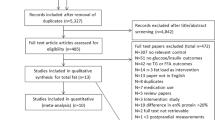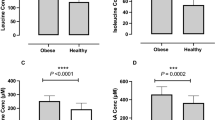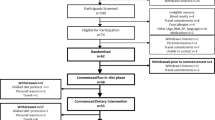Abstract
Background/objectives:
Dietary triacylglycerols (TAGs) containing palmitic acid in the sn-2 position might impair insulin release and increase plasma glucose. We tested this hypothesis by comparing postprandial responses to fats with varying proportions of palmitic acid in the sn-2 position.
Subjects/methods:
Using a crossover-designed randomized controlled trial in healthy men (n=25) and women (n=25), we compared four meals on postprandial changes in glucose (primary outcome), insulin, C-peptide, glucose, glucose-dependent insulinotropic polypeptide (GIP) and polypeptide YY (PYY) concentrations. The meals provided 14 g protein, 85 g carbohydrate and 50 g test fat, supplied as high oleic sunflower (HOS) oil (control), palm olein (PO), interesterified palm olein (IPO) and lard containing 0.6, 9.2, 39.1 and 70.5 mol% palmitic acid at sn-2, respectively.
Results:
No differences in plasma glucose, insulin and C-peptide response between meals were found. GIP release was lower (P<0.001) for IPO and lard compared with HOS and PO meals; the maximal increments (geometric mean and 95% confidence interval) for HOS, PO, IPO and lard were 515 (468, 569), 492 (448, 540), 398 (350, 452) and 395 (364, 429) ng/l, respectively. There was a trend for the postprandial increase in PYY to be lower in women on the IPO and lard meals than those on the HOS and PO meals.
Conclusions:
Dietary TAGs with an increased proportion of palmitic acid in the sn-2 position do not have acute adverse effects on the insulin and glucose response to meals in healthy men and women, but they decrease GIP release.
This is a preview of subscription content, access via your institution
Access options
Subscribe to this journal
Receive 12 print issues and online access
$259.00 per year
only $21.58 per issue
Buy this article
- Purchase on Springer Link
- Instant access to full article PDF
Prices may be subject to local taxes which are calculated during checkout





Similar content being viewed by others
References
Marangoni AG, Rousseau D . Engineering triacylglycerols: the role of interesterification. Trends Food Sci Tech 1995; 6: 329–335.
Berry SE, Miller GJ, Sanders TA . The solid fat content of stearic acid-rich fats determines their postprandial effects. Am J Clin Nutr 2007; 85: 1486–1494.
Sundram K, Karupaiah T, Hayes KC . Stearic acid-rich interesterified fat and trans-rich fat raise the LDL/HDL ratio and plasma glucose relative to palm olein in humans. Nutr Metab (Lond) 2007; 4: 3.
Zock PL, de Vries JH, de Fouw NJ, Katan MB . Positional distribution of fatty acids in dietary triglycerides: effects on fasting blood lipoprotein concentrations in humans. Am J Clin Nutr 1995; 61: 48–55.
Hayes KC, Pronczuk A . Replacing trans fat: the argument for palm oil with a cautionary note on interesterification. J Am Coll Nutr 2010; 29: 253S–284S.
Berry SE, Woodward R, Yeoh C, Miller GJ, Sanders TA . Effect of interesterification of palmitic acid-rich triacylglycerol on postprandial lipid and factor VII response. Lipids 2007; 42: 315–323.
Costarelli V, Sanders TA . Acute effects of dietary fat composition on postprandial plasma bile acid and cholecystokinin concentrations in healthy premenopausal women. Brit J Nutr 2001; 86: 471–477.
Baggio LL, Drucker DJ . Biology of incretins: GLP-1 and GIP. Gastroenterology 2007; 132: 2131–2157.
Cho YM, Kieffer TJ . K-cells and glucose-dependent insulinotropic polypeptide in health and disease. Vitam Horm 2010; 84: 111–150.
Asmar M, Simonsen L, Madsbad S, Stallknecht B, Holst JJ, Bulow J . Glucose-dependent insulinotropic polypeptide may enhance fatty acid re-esterification in subcutaneous abdominal adipose tissue in lean humans. Diabetes 2010; 59: 2160–2163.
Kim SJ, Nian C, McIntosh CH . GIP increases human adipocyte LPL expression through CREB and TORC2-mediated trans-activation of the LPL gene. J Lipid Res 2010; 51: 3145–3157.
Lardinois CK, Starich GH, Mazzaferri EL, DeLett A . Effect of source of dietary fats on serum glucose, insulin, and gastric inhibitory polypeptide responses to mixed test meals in subjects with non-insulin dependent diabetes mellitus. J Am Coll Nutr 1988; 7: 129–136.
Thomsen C, Storm H, Holst JJ, Hermansen K . Differential effects of saturated and monounsaturated fats on postprandial lipemia and glucagon-like peptide 1 responses in patients with type 2 diabetes. Am J Clin Nutr 2003; 77: 605–611.
Ueno H, Yamaguchi H, Mizuta M, Nakazato M . The role of PYY in feeding regulation. Regul Pept 2008; 145: 12–16.
Karra E, Batterham RL . The role of gut hormones in the regulation of body weight and energy homeostasis. Mol Cell Endocrinol 2010; 316: 120–128.
Maljaars J, Romeyn EA, Haddeman E, Peters HP, Masclee AA . Effect of fat saturation on satiety, hormone release, and food intake. Am J Clin Nutr 2009; 89: 1019–1024.
Sanders TA, Filippou A, Berry SE, Baumgartner S, Mensink RP . Palmitic acid in the sn-2 position of triacylglycerols acutely influences postprandial lipid metabolism. Am J Clin Nutr 2011; 94: 1433–1441.
Yli-Jokipii K, Kallio H, Schwab U, Mykkanen H, Kurvinen JP, Savolainen MJ et al. Effects of palm oil and transesterified palm oil on chylomicron and VLDL triacylglycerol structures and postprandial lipid response. J Lipid Res 2001; 42: 1618–1625.
Yli-Jokipii KM, Schwab US, Tahvonen RL, Kurvinen JP, Mykkanen HM, Kallio HP . Chylomicron and VLDL TAG structures and postprandial lipid response induced by lard and modified lard. Lipids 2003; 38: 693–703.
Zampelas A, Williams CM, Morgan LM, Wright J, Quinlan PT . The effect of triacylglycerol fatty acid positional distribution on postprandial plasma metabolite and hormone responses in normal adult men. Br J Nutr 1994; 71: 401–410.
Lopez S, Bermudez B, Ortega A, Varela LM, Pacheco YM, Villar J et al. Effects of meals rich in either monounsaturated or saturated fat on lipid concentrations and on insulin secretion and action in subjects with high fasting triglyceride concentrations. Am J Clin Nutr 2011; 93: 494–499.
Lopez S, Bermudez B, Pacheco YM, Villar J, Abia R, Muriana FJ . Distinctive postprandial modulation of beta cell function and insulin sensitivity by dietary fats: monounsaturated compared with saturated fatty acids. Am J Clin Nutr 2008; 88: 638–644.
Pertwee RG, Howlett AC, Abood ME, Alexander SP, Di Marzo V, Elphick MR et al. International Union of Basic and Clinical Pharmacology. LXXIX. Cannabinoid receptors and their ligands: beyond CB(1) and CB(2). Pharmacol Rev 2010; 62: 588–631.
Cooper JA, Watras AC, Paton CM, Wegner FH, Adams AK, Schoeller DA . Impact of exercise and dietary fatty acid composition from a high-fat diet on markers of hunger and satiety. Appetite 2011; 56: 171–178.
Yabe D, Seino Y . Incretin actions beyond the pancreas: lessons from knockout mice. Curr Opin Pharmacol 2013; 13: 946–953.
Dockray GJ . Enteroendocrine cell signalling via the vagus nerve. Curr Opin Pharmacol 2013; 13: 954–958.
Papamargaritis D, Panteliou E, Miras AD, le Roux CW . Mechanisms of weight loss, diabetes control and changes in food choices after gastrointestinal surgery. Curr Atheroscler Rep 2012; 14: 616–623.
Holst JJ, Vilsboll T, Deacon CF . The incretin system and its role in type 2 diabetes mellitus. Mol Cell Endocrinol 2009; 297: 127–136.
Acknowledgements
This work was supported by a grant from the Malaysian Palm Oil Board. Oils and fats were provided by Archer Daniels Midland Pura Limited, Erith, UK Archer Daniel Mills and interesterified products by Unimills BV, LE Zwijndrech, Netherlands free of charge. We thank Jo Bruce (Archer Daniels Midland Pura Limited, Erith, UK) for providing the test fats, Dr Martijn Zieverink (Unimills BV, LE Zwijndrech, Netherlands) for performing the interesterification and the Malaysian Palm Oil Board for providing financial support. We also thank Virginia Govoni, Sonia Edmondson and Victoria Feenie (King’s College London) for their assistance in conducting the study and Dr Roy Sherwood and Tracy Dew of the Clinical Chemistry Department, King’s College Hospital for measuring the insulin, C-peptide and gut hormones.
Author information
Authors and Affiliations
Corresponding author
Ethics declarations
Competing interests
The authors declare no conflict of interest.
Additional information
Contributors: Tom Sanders, Sarah Berry and Ronald Mensink conceived and devised the study and contributed to the running of the study and analysis and writing of the manuscript. Androulla Filippou organized and conducted the study at King's College London and contributed to the sample analysis and writing of the manuscript. Sabine Baumgartner organized and conducted the study at the University of Maastricht and contributed to sample analysis.
Supplementary Information accompanies this paper on European Journal of Clinical Nutrition website
Supplementary information
Rights and permissions
About this article
Cite this article
Filippou, A., Berry, S., Baumgartner, S. et al. Palmitic acid in the sn-2 position decreases glucose-dependent insulinotropic polypeptide secretion in healthy adults. Eur J Clin Nutr 68, 549–554 (2014). https://doi.org/10.1038/ejcn.2014.49
Received:
Revised:
Accepted:
Published:
Issue Date:
DOI: https://doi.org/10.1038/ejcn.2014.49
This article is cited by
-
Effects of two consecutive mixed meals high in palmitic acid or stearic acid on 8-h postprandial lipemia and glycemia in healthy-weight and overweight men and postmenopausal women: a randomized controlled trial
European Journal of Nutrition (2021)
-
Interesterified palm olein lowers postprandial glucose-dependent insulinotropic polypeptide response in type 2 diabetes
European Journal of Nutrition (2019)
-
The amount and types of fatty acids acutely affect insulin, glycemic and gastrointestinal peptide responses but not satiety in metabolic syndrome subjects
European Journal of Nutrition (2018)
-
Sonocrystallization of Interesterified Fats with 20 and 30% C16:0 at sn-2 Position
Journal of the American Oil Chemists' Society (2017)
-
Modulation of postprandial lipaemia by a single meal containing a commonly consumed interesterified palmitic acid-rich fat blend compared to a non-interesterified equivalent
European Journal of Nutrition (2017)



